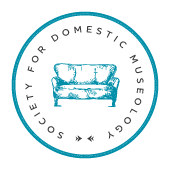Tucked away on the 3rd floor of that red-white-and-blue self-storage building you can see from the BQE, is Ti (Treasure Island), a warren of over 180 artist studios. On an uncharacteristically sunny day at the end of March, Domestic Museology members gathered for a private visit to the studios of Spring Hofeldt, Katherine Keltner, Jon Bunge, Annie Coggan, and ended with a tour of Elise Putman's exhibition, "White Woman, White Lady, White Girl". I love these small group studio visits and am always grateful to artists who invite us into their workspace to share work in progress and to talk about the ebb and flow of their daily creative practice.
We started in the shared sun-filled studio space of Spring Hofeldt and Katherine Keltner. Each of them address the minutiae of daily life, but through a different lens. Spring’s work centers on the sublime in the domestic: the quirky serendipty that occurs when your child takes two random things and puts them together. Staging objects of everyday life into symbolic tableaux, she meticulously paints these still lives to create a world at once photo-real and surreal, funny and poignant. Each painting is labor intensive and she then reproduces them in limited edition photographic prints.
Katherine’s work is both abstract and autobiographical. Her spray paintings highlight the negative space around the local weeds she collects in Red Hook, and her limited palette and grid-like structure evoke cyanotypes, and botanical specimens. It was fascinating to hear about her process and the way her work functions as a kind of cartography of personal history and place, while focusing on finding beauty in the mundane.
Annie Coggan is a designer, writer and teacher who is actively engaged in historical research as a foundation on which she bases much of her work. Her colorful studio is brimming with material studies of embroidery, smocking, interiors and furniture - all tangible manifestations of her design thinking process. Working on multiple projects at once, each seems to be in conversation with the other and it was intriguing to learn about her approach to her work. I left with a whole new understanding of chairs and a hankering to take one of her classes.
A visit to Jon Bunge’s studio is like stepping into an indoor forest, smelling of pine needles. Jon’s early work was based in two dimensional, abstract collage, but a sculpture class in graduate school pushed him to consider using wood as a collage material eventually exploring - and then limiting himself to - branches. His kinetic, often hanging, sculptures magnify the essence of the branches he is using, while also creating a very present negative space. Meant to be hung in installations and lit so they produce shadows, they create an atmosphere of reverence. His materials are organized by species and characteristic, creating a “branch library” (no pun intended) from which he selects his components, allowing the natural forms guide the sculptural forms.
To conclude our tour, we were fortunate to see Elise Putnam’s installation of drawings and sculpture entitled, “White Woman, White Lady, White Girl” at Ti’s Sweet Lorraine Gallery and to hear her talk about her work. Taking on the murky and uncomfortable intersection of race and feminism against the backdrop of art history, Elise uses her own body as a subject to disrupt unconscious and accepted assumptions about whiteness. These complex, large-scale works are rendered in crayon, fabric collage, and embroidery - media associated with women and children and many depict fairy tale archetypes: Goldilocks, Little Red Riding Hood, The Tooth Fairy. Yet, through gesture and expression, Putnam exposes and then subverts our expectations of beauty and race. She referred to her abstract sculpture as “White Anxiety” a tangible manifestation of what feels so culturally relevant right now. Her work is so honest and thoughtful about what is necessary for white people to address about our own history and privilege if we are to truly join racial justice conversation.






